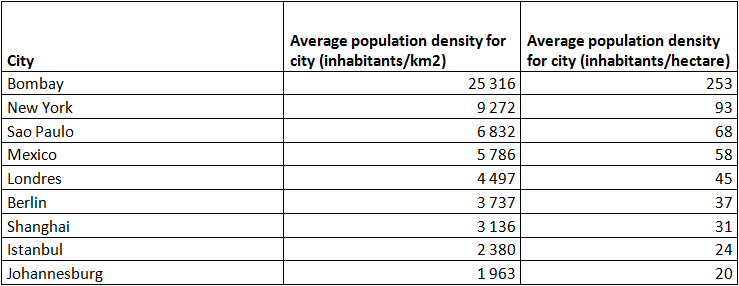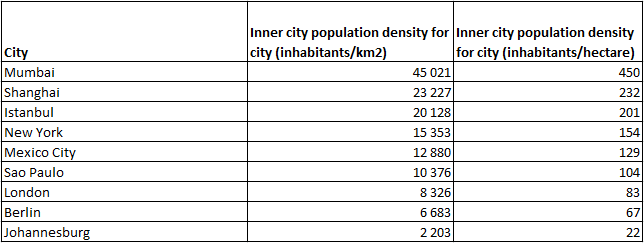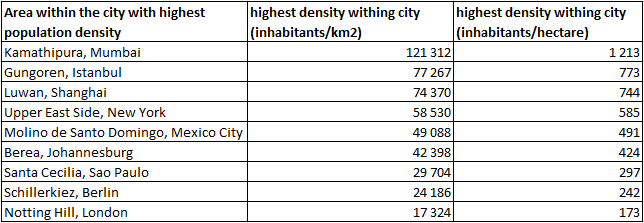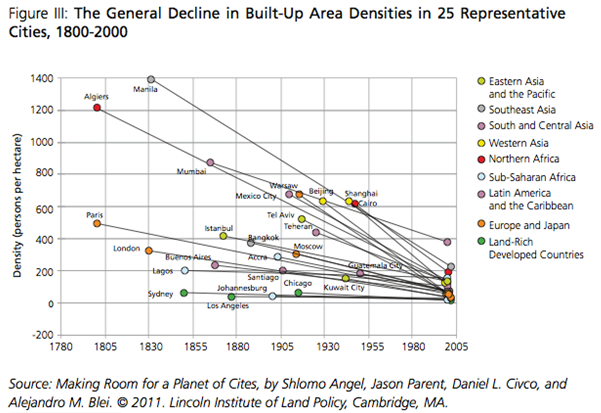Our urban future: the compactness factor
“Cities, like dreams, are made of desires and fears, even if the thread of their discourse is secret, their rules are absurd, their perspectives deceitful, and everything conceals something else.” Italo Calvino’s analogy, found in Invisible Cities – a seminal work for generations of architects and urban planners, sheds light on a characteristic of cities that cannot be ignored, even in an attempt to analyse the contemporary urbanisation dynamics.
Indeed, imaginaries tend to characterise how societies – in a time where more than half of the world population lives in cities – mediate their experience of the space they inhabit. In this regard, one could argue that a negative collective imaginary has historically surrounded cities, from Sodom and Gomorrah to their contemporary association with poverty, disease, and disintegration of communities and traditional values. The promiscuity — associated to the sharing of space and density of population – which defines the experience of many city-dwellers has led to strongly antagonising rural and urban spaces, respectively natural and artificial, pure and impure. Throughout history, urban planners have embraced this paradigm: Ebenezer Howard’s “Garden City” of 1898 was an attempt to recreate traditional village life in urban centres, so as to entertain the myth of a lost Eden to transform the city’s chaos. In fact, this is not merely a remnant of popular beliefs, insofar as a survey undertaken in 2007 1 illustrates how several countries throughout the world have implemented policies designed to reduce migration flows to cities and rural exodus. Government officials who were respondents to these surveys associated urbanisation in developing countries to slums, grinding poverty, deficient infrastructure and pollution.
This is not to say the latter do not characterise mega-cities of the Global South such as Mumbai or Nairobi, but this tends to omit the great opportunity represented by urbanisation. Whether it be simple correlation or complete causality, history has proven how much urbanised societies thrive on various levels, as cities concentrate energies and encourage progress. As projections for the 21st century suggest the inevitability of a fast and global urbanisation trend, urban planners’ responsibility is to meet the demographic, economic, social and cultural challenges it presents with optimal planning practices, tailored for each different context. Indeed, to fully harness the complexity of the task at hand, one must first and foremost dispel the myth that a miracle solution can exist within the realm of urban planning. Urbanisation – especially in less urbanised countries – comes through mechanisms that have not been fully grasped, and therefore compels planners, decision-makers and communities to imagine and create the city of tomorrow. Images associated to growing cities tend to portray endless and scattered housing units, sprawling towards the horizon, a testament to the bleak and alienating perception of cities highlighted above: far from discouraging urbanisation, this should spurn the development of ideas and projects aiming at transforming that reality, and at making the experience of urban space as rich, as pleasant, and as human as possible – leveraging that urban space to fit the needs and aspirations of its population, which means affecting the density and compactness of the living environment.

Inner city popuation density of a sample of world cities-District Scale*

Highest neighborhood densities wthin a sample of world cities*

*Source: Adapted from LSE & Deutsche Bank's Alfred Herrhausen Society, 2011. Living in the endless city. London: Phaidon Press Limited.
Albeit the notion that every geographical space thrives under its own specific set of rules, research supports the assumption that a certain set of guidelines can steer urbanisation towards more sustainable outcomes. Before delving in their particularities, it is important to comment on the protean concept of sustainability. Ecologically, it implies that the economy of urban space should have a low footprint on the environment, which means finding in the urban form and in the city’s architecture ways to minimise energy consumption, to manage waste effectively, and to build by collaborating with nature.
However, sustainability also suggests a strong thought given to the basic urban form, or more precisely to the “skeleton” of the city. Most of the thriving cities in today’s world developed around soundly planned public spaces: Haussmann’s arteries in Paris, or even the Ancient Roman street grid of Barcelona have consistently maintained the spatial identities of these global centres. Cities can be sustainable only if their design can successfully stand the test of time and if – like a building – they are built on solid foundations.
UN-Habitat, in its effort to develop practical and effective tools for urban planners, has drawn in recent years a path towards optimal urbanisation, illustrated by four adjectives to qualify well-planned cities, which represent altogether a new paradigm for urban spaces: compact, connected, integrated, inclusive.
Inclusiveness is a concept that stems from the idea that barriers should not be erected between urban populations. Therefore, planning processes should take on participatory practices, benefit primarily the poorest and more vulnerable, and policies should promote mixed-income areas. In fact, the goal is to avoid phenomena such as gentrification, particularly witnessed in the further stages of urbanisation in developed countries. If cities are seen as nodes clustering wealth and progress, the objective is to integrate them effectively into regional networks. Cities, indeed, are not islands – and urbanisation processes go beyond the limitations of urban space. Integrating a city means linking its “aura” to surrounding rural areas, and promoting its endogenous and local assets. Throughout the European “megalopolis” – from London to Milan and from Amsterdam to Paris – the energies harnessed by these urban nodes benefit the whole region, villages as well as intermediate cities. Not only is this perspective effective, but it also shatters the imaginary dichotomy between urban and rural, which has – as pointed out above – fuelled the negative perceptions highlighted in our introduction. Within the space of cities, the access to services is as important as the mere existence of these services. Hence the necessity to emphasise the connectivity of cities, and to understand the intrinsic shape of cities before drafting plans. In Mexico, a recent housing policy without proper planning led to the construction of 3.9 million housing units, which were left empty as they were too far from the employment place of targeted populations. Connectivity stems from a geographical analysis, yet goes beyond, insofar as it understands how much social and cultural values nodes and centres hold, in the context of a growing and transforming city.
By stressing the importance of planning processes of urbanisation, the implicit assertion is that the form of cities shapes the various interactions of a society, as well as the individual experiences of city-dwellers. In this regard, the contemporary perception of density seems to give credit to the paradigm shift at play in urban planning practices. As much as the geographical expansion of cities was a characteristic of the second half of the 20th century, a consensus is being found on how unsustainable – on many different levels – this model of urban growth is. As built environments become less dense and stocks of built up land accumulate, the amount of reproductive and ecologically buffering land available for ecosystems is diminished, reducing the ability of city-regions to support themselves 2.

Informal urban growths and spatial poverty traps, characteristic of the chaotic urban sprawls of developing countries, put even more the onus on the work of urban planners, and confirm the necessity for the city of tomorrow to be more compact, and thus more dense spatially.
Nevertheless, let us imagine the plight of an urban planner attempting to leverage the density of a city in Western Africa. After engaging with the vernacular of that urban space, from where would he start to find inspiration to project a more compact city? The answer lies in a set of experiences; not merely prone to being replicated, insofar as there are no unique solutions and no city – the epitome of a human construct – has achieved perfection in planning, but rather to be seen as examples, to provide empirical evidence of purposeful and successful practices, and to fuel the creativity and imagination of the people attempting to simply twitch or radically transform the form of their cities.
The capital of Burkina Faso, Ouagadougou, went through many transformations in the years of the “Great Urban Land Restructuring”, from 1983 to 1995. The radical revolutionary power became the proprietor of the land and steered urban development towards the destruction of unplanned settlements. From the original 71 per cent of the latter, in 1995 only 7 per cent of the total land area of Ouagadougou was made of unplanned settlements, leading the way for planned housing projects. However, the authoritarian characteristic of this project displayed its limitations when it pressured designers and planners, thus preventing them from mastering the expansion of the urban from. Urban sprawl resulted from these practices, and the ensuing difficulty to access basic services and utility networks hindered the development of Ouagadougou. Furthermore, the restructuring of land considerably ignited property speculation when customary land rights were reintroduced. The lessons learnt from this example are that progressive practices are an urban planner’s best ally towards leveraging density. Indeed, the sense of urgency impelled in Ouagadougou’s restructuring was detrimental to the carrying of the project. It is often repeated that strong decision-making – at times even authoritarian – offers great opportunities to city planning; in fact, its sustainability comes into question, insofar as the lack of progressive change hinders the long term success of such plans. In this regard, Ouagadougou is a case in point, illustrating how housing policies can only come with an overarching urban plan, so as to encourage the compactness of a city and prevent urban sprawl.
Another example of shift in institutional mindsets associated to urban planning was the Favela Bairro experiment in Rio de Janeiro, Brazil. Funded by the Inter-American Development Bnak (IDB), it concerned in the 1990s medium-sized favelas, and aimed at bridging the physical and symbolic gap between a very entrenched city. Decentralisation of decisions was the cornerstone of the success of the project, insofar as it allowed planning processes to promote grassroots project management. The plague ailing favelas is mainly overcrowded neighbourhoods that lack infrastructure; the Favela Bairro project thus focused on a plan to service housing units, taking into account the idea that improvements come through various perspectives present in urban planning – basic services, landscaping strategies, but also public spaces. Empowerment meant allowing participatory practices in planning, but also community building, setting geographical limits to the uncontrolled and unregulated expansion of the informal settlements. Implementing certain standards in leveraging density allows planners – and subsequently populations – to further develop projects regarding the daily life of a neighbourhood. In the case of Rio de Janeiro’s favelas, pilot projects ambitioned to improve citizen security, in an effort to shift control from the favela’s drug lords back to its residents 3. Coming back to the institutional framework of these measures, the encouragement of community governance offered to slum-dwellers the possibility to improve directly their living condition. Therefore, the development of capacity is one of the keys to changing the deficient forms of certain cities. Nevertheless, in the political context of Brazil, the loss of confidence in decision-makers – due essentially to widespread corruption – forced planners to target specific achievements, and that is why Favela Bairro has been a successful project. The expected results include the regularisation of 18,000 homes, the issuance of 3000 property title and the creation of 45 new social services facilities 4.
Similarly to the geographical makeup of Rio de Janeiro, Medellin – Colombia’s second largest city – is also home to low-income informal settlements in the surrounding hills. In a bold move put forward in 2004, the world’s first modern urban aerial cable-car public transport service system was built, as a relatively cheap, clean and highly visible response to urban transport problems 5. This increase of connectivity was associated to neighbourhood upgrading, related to new social housing, schools, and support to micro-enterprises. Aerial cable cars are relatively cheap, and were thus financed jointly by the municipality and the metro company. Although they do not represent mass transportation, they still significantly changed the public life of the city. An interesting fact is that the areas around the cable cars line saw an upgrade in the stock of their social infrastructure. The participation of local manual labour to all public work associated to project helped involve communities in Medellin’s investments. In addition, one cannot ignore the environmental upgrade represented by the cable-cars: the hydro-electric powered infrastructure considerably reduced the emissions of CO2, as shown in the table below.
Beyond the practical achievements of such initiative, Medellin’s example offers an example of innovative thinking that planners would be well-advised to adopt. “Thinking outside the box” – albeit being a clichéd expression – is necessary, as it allows all stakeholders involved in a project to collaborate and join energies in order to make ideas and projects sustainable – the latter term being understood in a broad sense.
In urbanised countries, one of the main challenges is often the redevelopment of inner cities, at times prone to urban decline. In addition, the suburban myth has led Western cities to specific urban sprawls, where wealthy people leave city centres and thus accelerate their decay. In order to counter this dynamic and to give more compactness to its form, the Australian Federal Government’s “Building Better Cities” programme organised a targeted redevelopment of the Honeysuckle, an inner city neighbourhood on the waterfront of Newcastle, the sixth largest urban area of the country. After two decades of decline, the project aimed at increasing the attractiveness of the area, by stimulating economic growth, improving environmental conditions, and supporting sustainable practices. This development has been highly successful in utilising derelict land to provide high-density and affordable housing. In addition, the mixed-use model of land has proven its success in transforming and revitalising the city 6. The Honeysuckle project also proved how effective urban planning finds synergistic solutions for environmental (reducing the demands for urban sprawl), social (improve the quality of life in Newcastle) and economic (foster investments and revitalise the city) problems concurrently. The widespread institutional support garnered by this project allowed it to set benchmarks in design innovation and planning frameworks, but also to hasten delivery processes. By integrating in its raison d’etre the multi-faceted nature of urban ailments, the Honeysuckle project represents a great example of how planning can impact a space, and provide strategic solutions that go beyond the mere spatial reflection, or which rather incorporate spatial components to economic, social or cultural factors.
On the European continent, Barcelona is a city that stands out as a model city – as far as densification practices are concerned. Since the Olympic Games in 1992, the capital of Cataluña went through a transformation that has made it a model of sustainable urban regeneration. Stemming from a vibrant city centre and a history of optimisation of the spatial form, Barcelona has in twenty years considerably renewed its industrial districts, in order to create a “web” connecting them to the capital’s agglomeration. One of the examples is the area of Poblenou, uplifted into a sustainable urban node. The key to its success was its specialisation into a centre of research excellence, developed through productive partnerships between ten universities. The new found research centres and technology transfer offices were meant to attract international as well as national business institutions, offering them state-of-the-art infrastructure to develop its activities, and thus to invest on that specific territory. This project created an estimated 130,000 jobs, but it more importantly developed another facet of the city of Barcelona, clustering its competitiveness into specialised areas, thus allowing the city to become a hub for innovation.
The benchmark set by Barcelona and the other cities highlighted illustrates how dense and compact cities do not merely impact the purely geographical form, but rather provide economic and social benefits, and ensure the sustainability of the chosen development processes. In a century that will see a dramatic urbanisation trend, place will matter more than ever. The work of planners will thus increasingly impact the essential fabric of societies – which puts a particular onus on their responsibilities in shaping the cities of tomorrow.
http://www.constructif.fr/bibliotheque/2013-6/l-avenir-des-villes-denses.html?item_id=3330&vo=1
© Constructif
Imprimer
Envoyer par mail
Réagir à l'article